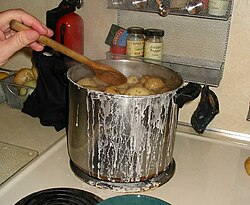It's an acquired taste, no doubt about it. Hot chicken is a local favorite in Music City, Nashville. The chicken breast becomes a blank canvas to paint with hot sauce and spices. And the degree of heat can vary, from Lil Spice and Lemon Pepper to XXX hot. It can clear the sinuses and take your breath away.
At Bolton's Spicy Chicken & Fish on the east side of town a well dressed woman in business pinstripes and high heels stepped up to the counter and said to the attendant, "Make it hurt." And before long she was walking back to a table carrying a wax paper package. Peeling back the wrapper she digs in to a massive hunk of fried chicken enveloped in a glistening veil of pepper-red crust accompanied by a pile of pickle chips. There is a slice of white bread on each side of the chicken to soak up the spicy grease. While it may look like a sandwich, the bones are still intact. So the woman begins to pick apart the chicken with her fingers.
With each bite, beads of perspiration build on the woman's brow. She undoes the top button of her blouse, removes her earrings and begins to sniffle and breathe heavily and fans herself. Finally when she wobbles to her feet to throw away the bones, she sighs, "I'll be okay," to no one in particular and steps out into the sunshine.
Here's the recipe for this infernal delight:
Nashville Hot Chicken
3 cups buttermilk 1 2 1/2-3 lb chicken cut into 8 pieces
3/4 cup cayenne Canola oil, for frying
9 Tbsp granulated garlic 2 cups self-rising flour
9 Tbsp paprika 6 Tbsp unsalted butter, melted
6 Tbsp onion powder sliced white sandwich bread
3 Tbsp sugar dill pickle chips, for serving
1. Combine buttermilk, 1/4 cup cayenne, 3 Tbsp each granulated garlic and paprika, 2 Tbsp onion powder, and 1 Tbsp sugar in a bowl and whisk until smooth. Add chicken and toss to coat; cover and chill at least 4 hours or up to overnight.
2. The next day, drain the chicken, rinse and pat dry; season with salt and pepper. Heat 2" oil in a 6 qt. saucepan until a deep-fry thermometer reads 300F. Stir remaining cayenne, granulated garlic, paprika, onion powder, and sugar in a bowl; transfer half to another bowl and whisk in flour. Working in batches, dredge chicken in flour mixture; fry, flipping once, until golden and almost cooked through, 6-7minutes,or until an instant read thermometer inserted into the thickest part of the chicken reads 150F. Transfer chicken to paper towels.
3. Increase oil temperature to 350F. Stir remaining cayenne mixture and melted butter in a bowl; set paste aside. Dredge chicken once more in flour mixture and fry until cooked through, 2-3 minutes more; drain briefly on paper towels and brush with reserved paste. Serve with bread and pickles.
Thanks to contributing editors Jane & Michael Stern who wrote about Nashville Hot Chicken in the June/July issue of Saveur magazine.































